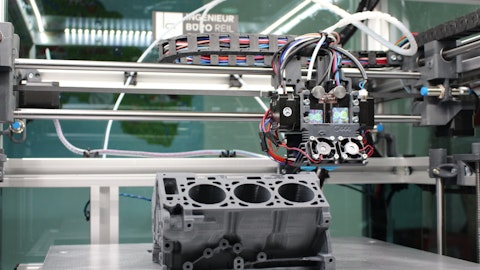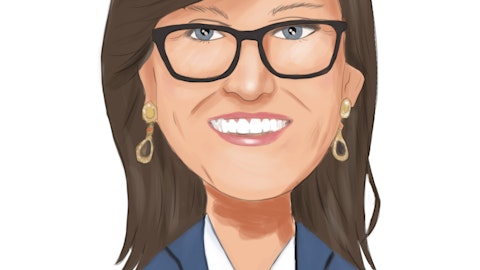Xometry, Inc. (NASDAQ:XMTR) Q4 2022 Earnings Call Transcript March 1, 2023
Operator: Good day, and thank you for standing by. Welcome to the Xometry Fourth Quarter 2022 Earnings Conference Call. At this time, all participants are in a listen-only mode. After the speakers presentation there will be question-and-answer session. . Please be advice that today’s conference is being record. I would now like to hand the conference over to your speaker today, Shawn Milne, Vice President of Investor Relations. Please go ahead.
Shawn Milne: Good morning, and thank you for joining us on Xometry’s Q$ 2022 Earnings Call. Joining me are Randy Altschuler, our Chief Executive Officer; and Jim Rallo, our Chief Financial Officer. During today’s call, we will review our financial results for the fourth quarter and full year 2022 and discuss our guidance for the first quarter and full year 2023. During today’s call, we will make forward-looking statements, including statements related to the expected performance of our business, future financial results, strategy, long-term growth and overall future prospects. Such statements may be identified by terms such as believe, expect, intend and may. These statements are subject to risks and uncertainties, which could cause them to differ materially from actual results.
Information concerning those risks is available in our earnings press release distributed before the market opened today and in our SEC filings included in the Form 10-K for the quarter ended December 31, 2022, that will be filed with the SEC. We caution you not to place undue reliance on forward-looking statements and undertake no duty or obligation to update any forward-looking statements as a result of new information, future events or changes in our expectations. We’d also like to point out that on today’s call, we will report GAAP and non-GAAP results. We use these non-GAAP financial measures internally for financial and operating decision-making purposes and as a means to evaluate period-to-period comparisons. Non-GAAP financial measures are presented in addition to and not as a substitute or superior to measures of financial performance prepared in accordance with U.S. GAAP.
To see the reconciliation of these non-GAAP measures, please refer to our earnings press release distributed today and our investor presentation, both of which are available on the Investors section of our website at investors.xometry.com. A replay of today’s call will also be posted on our website. With that, I would like to turn the call over to Randy.
Randy Altschuler: Thanks, Shawn. Good morning, everyone, and thank you for joining us for our Q4, 2022 earnings call. While Q4 was a challenging quarter for Xometry we continue to build global networks of buyers and suppliers and the technology tools that enable them to transact digitally. With our market leading position and a total addressable market of $2 trillion we expect to continue to grow rapidly for many years to come. We believe that continuing shift to digital is inevitable. And as the leading two sided marketplace our asset light digital marketplace creates efficiencies and values for buyers and suppliers alike. Our AI-powered algorithms generate instant prices and lead times and we efficiently connect buyers with the manufacturing technology and manufacturer which can drastically reduce time to market and strengthen global supply chains.
While there are no shortcuts, we are steadily and methodically executing on our vision of becoming the de facto digital rails for custom manufacturing. In Q4, revenue increased 46% year-over-year to $98.2 million driven by marketplace growth and expanding supplier services with the addition of Thomas. Q4 marketplace revenue was $79.1 million 32% year-over-year growth. Gross profit increased 72% year-over-year driven by 30% growth in marketplace gross profit and the addition of Thomas. Active buyers increased 45% year-over-year to 40,664 driven by a record addition of 3875 active buyers in Q4, a 17% increase over the prior record set in Q3. We also set a company record for the largest number of orders in a quarter, in part driven by record order count from existing accounts.
The revenue generated by these existing accounts also continues to grow at a rapid clip reflecting the stickiness of our marketplace. In the Q4 earnings presentation we updated the account cohort analysis that was in our 2021 S1 IPO filing to help quantify that growth. Active suppliers grew by 22% in 2022 equally important we increase our share of capacity with them, as our spend per supplier grew 22% year-over-year. Xometry’s international revenue grew 89% year-over-year and 15% quarter-over-quarter, driven almost entirely by the growth in our European business. Despite this growth in Q4, we fell short of expectations for the first time since becoming a public company. For only the second time in five years Xometry’s revenue decreased quarter-over-quarter.
We also saw a notable sequential quarter-over-quarter decline in marketplace gross margins for the first time since Q1 of 2021. With the revenue and gross margin shortfalls, we were not able to absorb operating expense growth, resulting in a higher than expected adjusted EBITDA loss of $14.2 million in Q4. We take this step back and profitability seriously. Accordingly, I’m going to provide a detailed explanation of what we learned in Q4 and the steps we’ve taken to mitigate any issues and ensure that Xometry continues to deliver a strong durable growth even in a challenging macroeconomic environment. We’ve already seen progress in Q1 and we are confident in our 2023 outlook. Here’s what we learned in Q4 and the steps we have taken to improve our go forward results based on this information.
First, as we talked about on our Q3 call, our suppliers, influenced in part by macroeconomic factors change their behavior, taking jobs at lower prices, further impacting pricing. In addition, our buyers traded off longer lead times for lower prices, further impacting average order value. In Q4, average order value in the U.S. marketplace declined approximately 8% quarter-over-quarter, negatively impacting revenue by $6 million to $7 million compared to expectations. Based on our pricing optimization efforts, we’re starting to see average order value rebound in the middle of Q1. Second, some of our largest customers grew less than expected late in Q4. We saw buyers delay their orders and in some cases, reduce expected order quantities. Their slowdown limited overall order growth to 41% year-over-year in the quarter, a decrease from what we experienced earlier in Q4.
The impact of this lower order growth reduced marketplace revenue by $3 million to $4 million in Q4. Our top 200 accounts represented approximately 50% of 2022 U.S. marketplace revenue. Historically, these accounts have grown significantly, yet Xometry still only has a small share of their wallet. In early 2023 we redirected salespeople and customer support against these accounts. Given the higher spend we have with these accounts, we are engaging in enterprise level discussions around strengthening supply chains and driving production order efficiencies. Third, in an environment of falling costs and slowing demand, we expanded our testing of buyer price elasticity to better understand the tradeoffs between price and conversion. This resulted in a drag on marketplace gross margin in Q4.
Using our learnings from Q4, we expect marketplace gross margin to largely rebound in Q1 of 2023. This will also enable Xometry to better manage future unexpected significant shifts in costs. Capitalizing on what we learned in Q4 and on the rapid growth of our active buyer base in Q1 of 2023 we expect to resume the quarterly sequential growth in revenue and gross profit we have delivered over the years. Likewise, we expect to lower adjusted EBITDA loss quarter-over-quarter. For 2023 overall, we expect to remain in strong growth mode and deliver healthy marketplace revenue growth of approximately 30%, marketplace gross margin expansion and improved operating leverage. Despite the headwinds of Q4 which carried into early Q1, we are committed to being adjusted EBITDA profitable in Q4 of 2023.
In addition to the changes I outlined earlier, here are our primary areas of focus in 2023. One, significantly expand the number of processes, materials and finishes, we can offer our customers so we become their one stop destination. It is extremely difficult for any single manufacturer, even those that are vertically integrated to have the exact capabilities to meet even a fraction of the customer needs. Thomasnet.com offers supplier capabilities across 70,000 categories. This depth and breadth is critical since our market is not defined by commodity parts or skews but instead is made up of 1000s of different use cases. This is one of the reasons that custom manufacturing market is so fragmented. Our marketplace is unique in its ability to meet these needs.
Customers are increasingly recognizing this capability as their production order volume grew significantly in 2022 from 2021. We are expanding our capabilities and improving the production buying experience in our platform in 2023. Two, continue to grow aggressively in Europe, including the recent expansion to the UK, which is the third largest manufacturing market in the region. Additionally, in early Q1, we made a small tuck in acquisition in Turkey to further expand our alternative cost supplier network to serve the European market. In Q4, international revenue grew more than 100% year-over-year on an FX neutral basis. Furthermore, we remain pleased with random buyer demand in China as we’re seeing orders from across many verticals including medical equipment, biotech, optical tech and smart equipment industries.
We expect China to contribute to revenue growth in 2023. Through Xometry.eu, xometry.uk, and Xometry, Asia, we’ve leveraged Xometry’s core technology to provide localized marketplaces in 13 different languages, with networks of suppliers across Europe and Asia, as well as North America. Three, continue to invest in our work center and industrial buying engine platforms, increasing our footprint with both buyers and suppliers, and enabling us to scale cost effectively. For our suppliers, we made important progress and work center. The SaaS like operating system that is the digital foundation for manufacturers. In Q4, we successfully migrated all Xometry suppliers to work center to utilize the job board and suite of job management tools. In response to supplier feedback, we improved the display and management of jobs and enhance the usability of the system on mobile devices.
In 2023, we plan to expand the work center job management tools and capabilities, including support for custom job workflows, job scheduling, and communication tools. For buyers, we took significant steps towards improving the industrial buying engine. The industrial buying engine digitizes the cumbersome and time consuming request for quote process, taking what was once off platform and integrating it into the heart of thomasnet.com. In Q4, the industrial buying engine continued to move on platform buyers requests for quotes. We saw an increased number of buyers building and submitting their industrial buying engine quote requests. We also saw suppliers beginning to use our on platform messaging tools to interact with buyers during the quote process.
While the revenue from the industrial buying engine transaction fees and thomasnet.com is not yet a significant revenue stream as we more tightly integrated with our instant quoting engine, we can increase our buyer share of wallet. Four, modernize the advertising products and continue to expand cell service options on the thomasnet.com platform, making easier for suppliers to start their advertising journey. We are moving to a pay for performance advertising model on thomasnet.com. Most search and listing engines that support advertising, use a pay per click or other performance based advertising model, which aligns the interests in buyers and suppliers. As we improve search, we expect to see a higher level of buyer engagement, improving the opportunity for search monetization.
This will also help drive growth of our higher margin suppliers services, as well as boost the use of the industrial buying engine. Five, aggressively look to increase efficiencies and reduce expenses across our organization. In January, we reduced our workforce by 6% to better streamline operations and improve efficiency and leverage. Our efficiency measures will generate operating savings of roughly $8 million on a full year basis. Jim Rallo will provide more context to these changes on our Q1 and ’23 guidance later in the call. The underlying metrics of the marketplace continue to be strong, with record additions of active buyers and record order accounts including from existing accounts. Our international business had a record quarter. We made good progress with the rollout and adoption of work center and building integrations to enable Thomas and Xometry users alike to access the breadth and depth of Thomasnet.com’s 500,000 suppliers, the full value of which we’re continuing to unlock.
I spend much of my time traveling and meeting with our customers. Whether it’s a hypergrowth aerospace company in California, or Fortune 500 consumer product company in the Midwest, buyers struggle with the same problem; efficiently finding solutions that meet the breadth and depth of their manufacturing needs. This highly free augmented, inefficient, opaque market provides worse outcomes for both buyers and suppliers. Our marketplace approach is the best solution to these problems, and we won’t stop until we fulfill their promise. With that, I will turn the call over to our CFO Jim Rollo for a closer look at fourth quarter financial results and our business outlook.

Copyright: nicoletaionescu / 123RF Stock Photo
Jim Rallo: Thanks, Randy. And good morning everyone. As Randy mentioned, we delivered solid marketplace growth in Q4 year-over-year despite increasing macro headwinds and changing buyer behavior. In early 2023 we took actions to reinvigorate marketplace growth and improve operating efficiencies and leverage. We generated Q4 revenue of $98.2 million up 46% year-over-year, driven by marketplace growth and the addition of Thomas and supplier services. The stronger U.S. dollar negatively impacted revenue by $1.1 million on a year-over-year basis. Q4 marketplace revenue was $79.1 million in supplier services revenue was $19.1 million. Q4 marketplace growth of 32% was driven by a strong increase in the number of active buyers year-over-year while revenue provider was impacted by lower pricing and softening order rates as Randy previously mentioned.
Q4 active buyers increased 45% year-over-year to 40,664. In Q4, the percentage of revenue from existing accounts was 96% underscoring the efficiency and transparency of our business model that leads to increasing account stickiness and spend over time. Once an account joins our platform, we aim to expand the relationship and increase engagement and spending activities from that account over time. The number of accounts with last 12 months spend at least 50,000 on our platform reached 1027 at the end of Q4 up 47% year-over-year. The strength of the U.S. dollar created a slight drag on metric for Q4 by approximately seven accounts. Supplier services revenue declined 2% quarter-over-quarter in Q4. The decline was primarily driven by seasonality in the Thomas business due to the timing of the publication of their trade magazine.
As expected, this impacted revenue by approximately 400,000 in Q4. Q4 gross profit was $36 million and increase of 72% year-over-year. Gross profit margin was 36.7%. Q4 gross margin for marketplace was 27.1% down 330 basis points quarter-over-quarter. The main driver was our pricing optimization testing which Randy previously mentioned. We expect marketplace gross margin to improve quarter-over-quarter from Q4 to Q1. Q4 gross margin for supplier services was 76.3% driven by the high gross margin of Thomas marketing and advertising services. Supplier services gross margin declined 220 basis points quarter-over-quarter due to the timing of the high margin and advertising revenue I previously mentioned and a higher mix of supplies which carries a much lower gross margin.
Moving on to Q4 operating costs. Q4 total non-GAAP operating expenses increased 53% year-over-year to $50.3 million driven by the addition of Thomas, continued investments in the business and incremental public company costs associated with Sarbanes Oxley. Within our operating expenses, sales and marketing is our largest variable component. In Q4 non-GAAP sales and marketing expenses were $22.3 million excluding stock based compensation, amortization and restructuring charges as compared to $12.4 million in Q4 2021. This increase in non-GAAP sales and marketing expenses on a year-over-year basis was driven by the addition of Thomas sales and marketing costs, continued investment to expand our network of buyers and suppliers, and hiring of additional salespeople to support strong growth in our land and expand strategy.
On a quarter-over-quarter basis, sales and marketing increased $2.8 million driven by continued investments and growing our network of active buyers. As Randy mentioned, we delivered record growth and new active buyers in Q4. Additionally, we invested $1 million to $1.5 million incrementally quarter-over-quarter to support further international expansion, including rapid growth in Europe, headcount to support the January launch in the UK, and ramping Asian business. Our adjusted EBITDA loss for Q4 was $14.2 million or 14.5% of revenue compared to 17.7% of revenue in Q4, 2021. Our Q4 adjusted EBITDA loss exclude a $1.5 million restructuring charge related to our workforce reduction. Turning to segment reporting. In Q4 revenue from our U.S. and international operating segments was $88.1 million and $10.1 million respectively.
Segment loss from our U.S. and international operating segments for Q4 was $20.5 million and $3.9 million respectively. We continued to invest in our international business, which grew 89% year-over-year in Q4, and 105% year-over-year on an FX neutral constant currency basis. At the end of the fourth quarter cash and cash equivalents were $319.4 million. Now moving on to guidance. We expect Q1, 2023 revenue in the range of $100 million to $102 million representing year-over-year growth of 20% to 22%. We expect marketplace revenue to grow in the mid to high 20% range year-over-year. We expect marketplace gross margin to improve in Q1 quarter-over-quarter driven by our pricing optimization efforts. In Q1, we expect adjusted EBITDA loss to be in the range of $9 million to $11 million, or 9% to 11% of revenue compared to a loss of $12.7 million or 15.2% in Q1, 2022.
Q1 adjusted EBITDA loss will be lower quarter-over-quarter driven by the growth in marketplace revenue and gross margin and the efforts to streamline operating expenses discussed earlier. In Q1, we expect stock based compensation expense to be approximately $5 million to $6 million, which we will exclude from adjusted EBITDA. We expect 2023 revenue of $470 million to $480 million, representing 23% to 26% growth year-over-year. We expect marketplace growth in a 30% range year-over-year, based on current marketplace trends. We expect to be profitable on an adjusted EBITDA basis in Q4, 2023 which is a change from our prior expectations for the second half of 2023. We expect improved operating leverage through 2023 driven by strong buyer in order growth and further improvement in gross margins driving faster gross profit growth in marketplace.
We expect significant leverage over fixed and semi-fixed costs, including public company costs. Additionally, our January reduction in workforce will reduce operating expenses by roughly $8 million on a four year basis. With that Operator, can you please open up the call for questions?
See also 11 Most Profitable Energy Stocks and 10 Best Stocks to Buy for Good Returns .
Q&A Session
Follow Xometry Inc.
Follow Xometry Inc.
Operator: Our first question comes from line of Brain Drab from William Blair. Your line this morning.
Brain Drab: Good morning. Thanks for taking my questions. Randy, maybe you can start just by talking about what you’ve learned since we spoke last regarding why suppliers are accepting jobs at such a faster rate. And how did that job acceptance, how did the speed of the acceptance trend throughout the fourth quarter and into this year?
Randy Altschuler: Yes, so Brian, good morning. So as we indicated, we did see pricing continue to fall through the quarter and buyers or suppliers were just more willing than ever to take prices at those lower rates. And that continued to drive down the AOV as the quarter progressed and then you couple that with we talked about slowing ordered growth from our largest account. And that just ended up being a double whammy for us.
Brain Drab: Right. And so have you seen those acceptance feeds change at all? I mean, it was a sudden kind of a sudden drop of 30 something percent. So at the end of the third quarter. They’re stepping faster now than they were before or is that leveled off?
Randy Altschuler: Yes. So we’re seeing now prices. I mean, there are a couple of dynamics at work. One is as we indicated, we were also doing some price optimization testing in Q4 and so and that dragged into the beginning of this of Q1. So in January Q1. We want to make sure we got it right. So now, as we’re taking those learnings we’ve been optimizing prices, and so even on, so let me just look at that, just from the price perspective, you’re seeing that we’re, very selectively raising prices and optimizing it also trying to make sure that we’re going to maintain that very strong order growth that we’ve been seeing. At the same time, you are seeing stabilization from suppliers at the prices, that they’re willing to take things. And so even though in January we saw a relatively low AOV, in February, that’s been trending back up. And so overall that trend is going higher.
Brain Drab: Okay, just one last question on this. I mean you’ve been experimenting with the price, experimenting at lower levels, I guess. But now, price is coming back up a little bit. Are you still in the fermentation phase? Or do you feel like you’ve something figured out that you had before? And where should we expect price to go in March and beyond? I guess it’s going to continue to creep up?
Randy Altschuler: Yes. I think we are, we’ve consolidated the learnings that we’ve had and what we were aggressive in Q4, sort of in response to the trends, we were seeing. We thought we took that as an opportunity to really invest into testing. But we’ve taken those and now you’re going to see the AOVs grow as a result of us testing and picking those learnings and optimizing pricing, as we said, raising prices, where we think we have the room to do that without impacting this healthy growth in orders that we’ve been experiencing.
Brain Drab: Okay, thanks very much. I’ll get back in line.
Randy Altschuler: No problem.
Operator: Thank you. One moment for our next question. And our next question comes from the line of Matthew Hedberg from RBC Capital Markets. Your line is open.
Matthew Hedberg: Great, guys. Thanks. Randy. I’m wondering if there’s any more clarity on maybe why suppliers are accepting orders at a lower rate? And just to be clear, are you sure there’s not a competitive reason maybe causing some of these buyers and sellers decisions?




